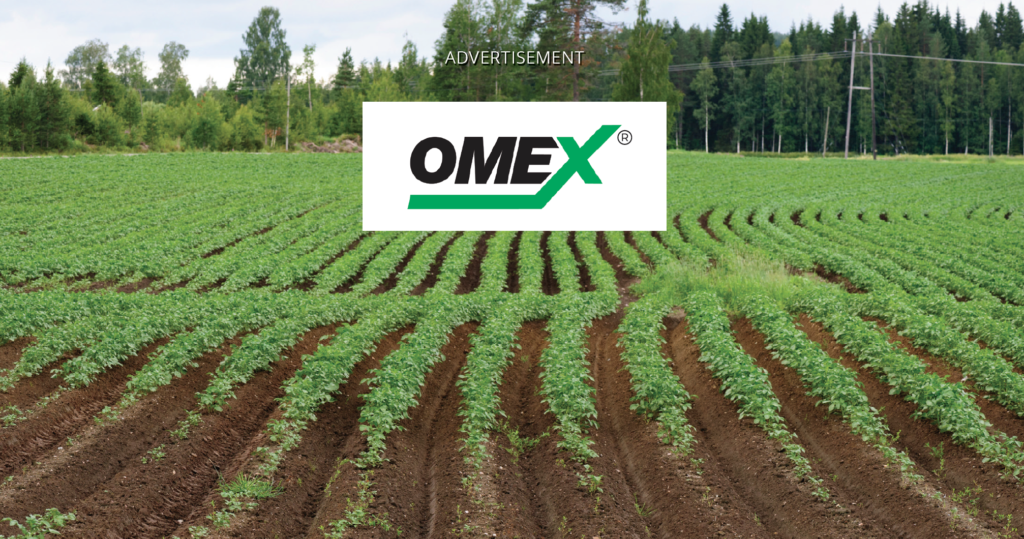Making best use of sulfur in the potato crop

{Sponsored} One of the most widely used and well-known products in American agriculture has been used as a fertilizer and a pesticide for more than 100 years. Should growers now ignore sulfur in favor of newer, more modern crop inputs?
Not a bit of it, says Mike Williams, CEO of crop nutrition specialists OMEX® Agrifluids USA. This vital, basic element ranks alongside nitrogen, phosphorus and potassium in importance. If, as a potato grower, you’re focused only on NPK — you’re holding back your crop.
Few people would find reason to criticize efforts to improve air quality. But to some extent, farmers have a legitimate gripe: cleaner air has created nutritional deficiencies in America’s crop fields.
Sulfur, specifically. For years, the fumes from power plants carried with them so much sulfur that crops never displayed deficiencies. Much like another vital input in crop production — sunlight — we never thought to supplement it because there was always enough. Sulfur became the ‘invisible’ macronutrient.
Now that we recognize the effects of burning fossil fuels — acid rain, particulates, excess carbon dioxide — it’s right to clean up and reduce emissions; no-one wants to repeal the Clean Air Act.
But as so often happens, the law of unintended consequences has exerted itself: our soils no longer receive the annual sulfur ‘bounty’. EPA data shows sulfur emissions fell 94 percent between 1990 and 2019. Farmers must make up for the sulfur deposits they previously enjoyed ‘for free’.
As successive crops take their fill, many fields now run a sulfur deficit.
Why is sulfur so important?
It’s the ‘fourth macronutrient’. Whatever the crop, sulfur’s role in crop biochemistry can’t be ignored. Of similar importance to nitrogen or phosphorus, it supports plant functions that can affect yield, quality and marketability.
Potatoes demand adequate sulfur levels for nitrogen uptake, chlorophyll production, tuber development, stress and pest resistance, carbohydrate generation, amino acid formation and vitamin synthesis. Decreased efficiency in any area becomes a limiting factor on crop yield and potential, while it also plays a significant role in how crops taste and smell, and how they perform in subsequent use. For example, the all-important gluten in wheat — giving bread its chewy, soft texture — depends on sulfur-sulfur bonds. Good breadmaking wheat needs good sulfur.
What’s more, across all crops, sulfur deficiencies rarely present with visible symptoms. Hidden deficiency is often more damaging than acute deficiency, as it’s usually only discovered when it’s too late to remedy.
Sulfur also has another role, as a fungicide. Indeed, sulfur-based fungicides were amongst the first available to farmers and they remain important today, whether applied to cut seed or as a supplement in conjunction with modern blight control chemistry.
What’s the solution?
It’s important to understand how plants absorb sulfur. Their preference is for sulfates: this is the only form in which plant roots can access the nutrient. There’s a limited role for leaves: not only can they absorb small quantities of sulfur dioxide direct from the atmosphere, they also help to regulate nutrient absorption while combating disease.
When applied as a foliar spray, the nutrients slowly enter the plant tissue as required. But when present on the leaf surface, sulfur’s disease-suppressing abilities act in synergy with later applications of fungicide and insecticide. So a healthy plant can stave off infections itself, putting less strain on modern fungicides within the program and reducing the risk of fungicide resistance.
It’s no coincidence that the incidence of diseases such as blight increases where potato plants display even moderate sulfur deficiency. Yet during the growing season, a crop’s sulfur requirements can often greatly exceed the soil’s inherent capacity to supply it — particularly as levels are now in decline.
Choosing the right product is important. At OMEX®, our focus is on products that are immediately bioavailable, either because they’re unaffected by soil microbial activity or because they take advantage of specific plant characteristics.
OMEX Sulphomex Ultra® is our solution for potatoes. Although it contains multiple sulfur sources, it’s not registered as a fungicide, but as a fertilizer — reflecting the importance of sulfur we’ve already described. Its co-formulation of sulphate and nitrate allows immediate use by the plant of the form of nitrogen most readily absorbed by plant roots.
As for sulfur ‘philosophy’, i.e. application, take the little and often approach. This way, you’ll not only reduce leaching — environmentally unsound but also representing an immediate loss to your bottom line — but maintain sulfur at sufficient levels both in the soil and on the leaf, such that it’s always available to the potato crop during periods of rapid growth. In this way, lack of sulfur is never going to become a limiting factor in your pursuit of optimizing yield potential!
Consult your agronomist for the rate of Sulphomex Ultra® that’s right for your crop. Between 1 and 3-1/2 pints per acre, integrated into early season insecticide and fungicide sprays, will not only build sulfur content within the plant, but also provide the crop with a additional mode of suppressive action that can build the foundation for a healthy, high-yielding and disease-free crop.
Learn more at www.omexusa.com.
The product names and brands referenced here are registered and trademarks of OMEX® Agrifluids, Inc.
© OMEX® Agrifluids, Inc. 2021.







